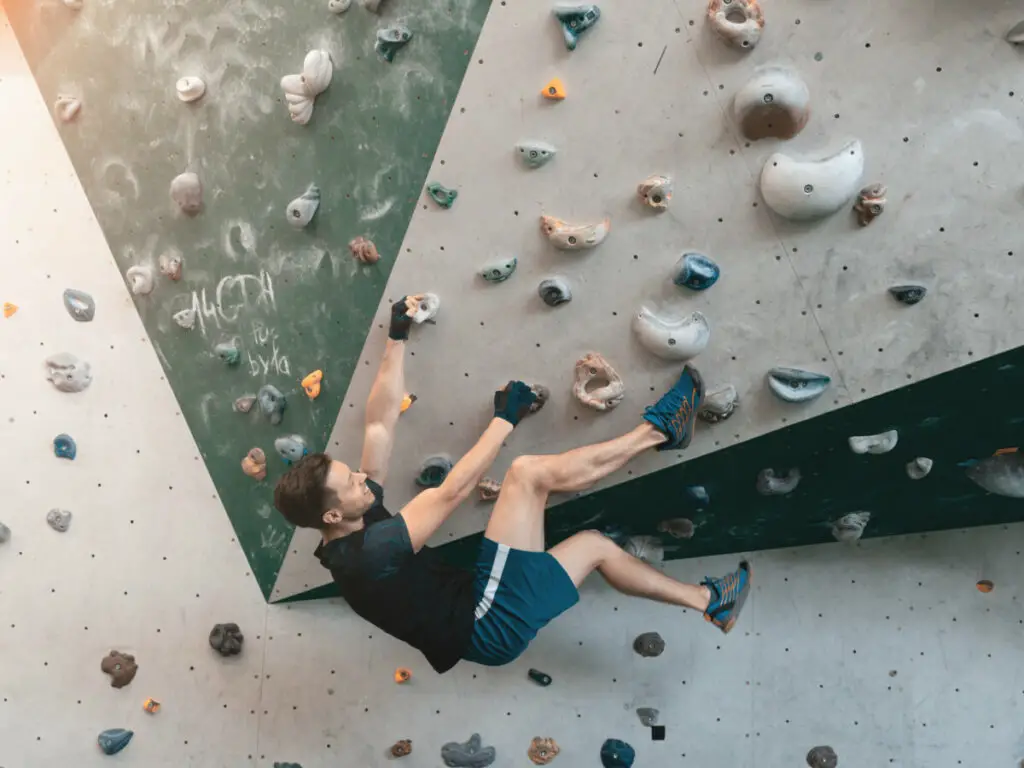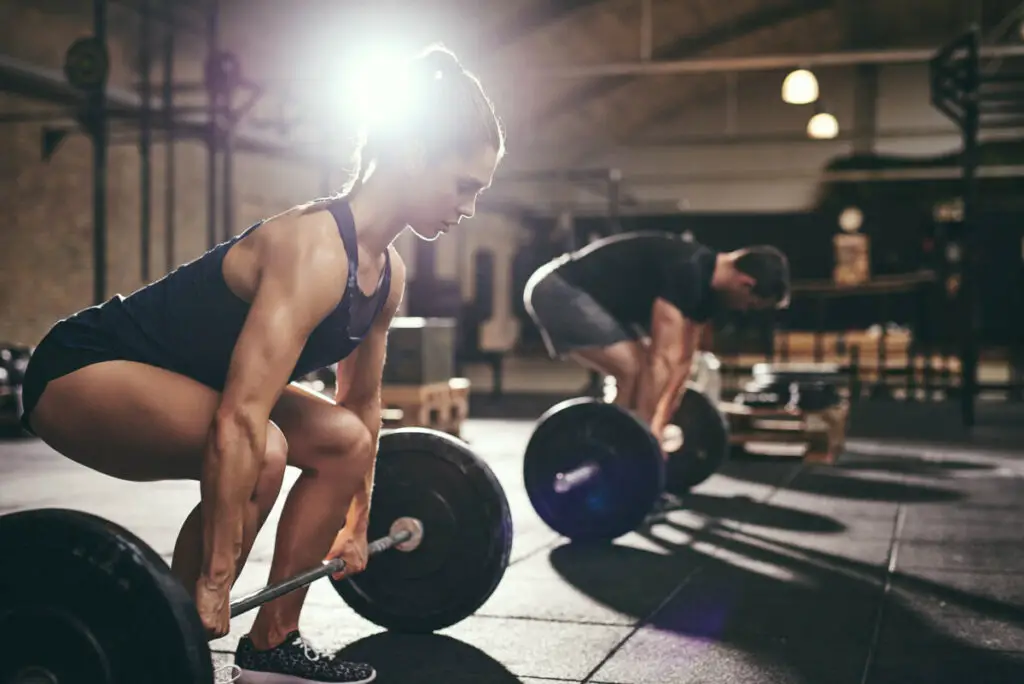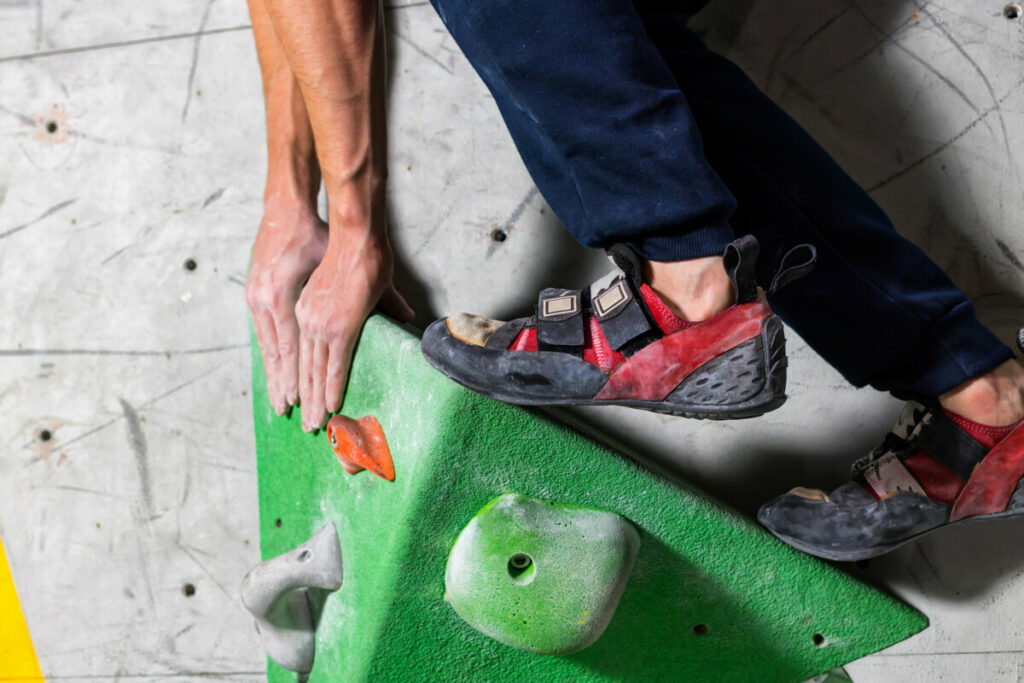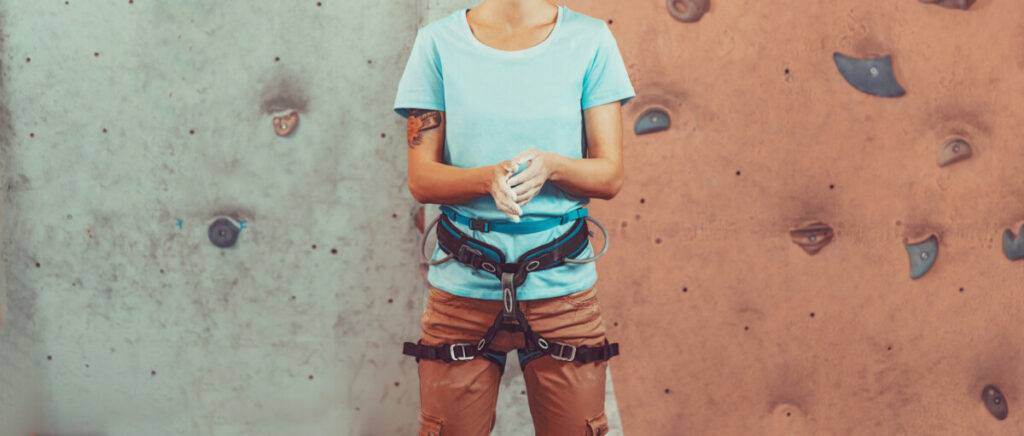
The odds that you have heard of rock climbing are very high, however, have you ever heard of “bouldering”? Perhaps most of you will not and if so, you may think that bouldering and rock climbing are synonymous. To a degree, they are, however, bouldering does not require the use of harnesses or ropes. This article will teach beginners how to prepare and safely participate in this activity, and even experienced climbers may continue to gain knowledge from this.
The best bouldering tip is to understand that the entire body is key to successful bouldering. Proper use of arms, legs, back, and torso will help manage and sustain movement up the wall, along with proper shoes and other safety measures. Don’t go bouldering, unless properly trained.
This may sound like an easy stroll; however, you must train both endurance and strength to get the most from bouldering. Again, safety precautions are to be observed. We will now go ahead and explore the methods one should take before they go bouldering.
What is Bouldering?
In order to begin bouldering, we should consider what bouldering exactly is. Simply put, bouldering is rock climbing but on a smaller scale (12-15 ft) that, again, does not utilize the use of ropes or harnesses. Rocking climbing is usually scaled at heights that reach around 30 feet (Bouldering vs Climbing: training, skills, strength, grades, – Send Edition). This is the primary difference between bouldering and rock climbing. Other than these differences, both are fundamentally similar in the strength and endurance category required to properly and safely scale any kind of rock wall with ease.
Some may consider bouldering as a “better” form of rock climbing and from my experience, they both have their benefits and cons. One benefit for both is the constant strength and endurance you gain while climbing consistently. Muscle memory is powerful in adjusting to its environment such as scaling a rock wall.
Another benefit for both is that shoe purchases will transfer one from the other. The only consideration is that outdoor shoes are great for indoor use but indoor shoes aren’t great for outdoor use. Finally, a benefit from rock climbing over bouldering is that you are safely secured when accidents do happen. The ropes, harnesses, and the belayer are there to catch your fall and safely secure you while bouldering does not, no matter how high.
Now that we understand, briefly, what bouldering entails and some pros and cons to it, let’s finally know what we need to do to prepare for bouldering effectively and safely.
Body Requirements for Bouldering
Let’s start with the most obvious concern for bouldering, and that is the body itself. Bouldering is a strength and endurance-based activity that requires fluid movement up and around the wall throughout the activity. An even distribution of weight while being on the wall is everything as well.
For example, beginners to either rock climbing, or bouldering will tend to waste most of their energy and strength solely in the arms, believing that upper body strength is the mainstay of effective climbing. You may get away with overexertion of arm strength with rock climbing since you are secured with ropes and harnesses, but with bouldering, you must realize that you are not secured and even a 12-foot drop will be dangerous. Do not rely on arms only but legs too.

The legs are just as important as the arms and biologically, legs are far superior to arms regarding muscle mass and bone density (Why Are Legs Stronger Than Arms? – Stamina Comfort). They are constantly carrying our full body weight and should be equally utilized in climbing than do the arms. Since legs are carrying our full weight, it is only natural that we utilize their “pushing” motions to allow us to gain leverage as we scale the rock wall in bouldering.
Regarding the “pushing” motion, for bouldering, we want our legs to do most of the pushing while our arms focus on the “pull” aspect. You can think of it like this, we use our legs to gain height, while our arms are to stabilize the height gained and to pull enough to allow our legs to find a new leverage point. Every inch we make up the wall we should be utilizing all limbs and our torso as well.
The reason I bring up the torso as a key factor in effective and safe climbing is that bouldering uses the core or the abdominals. Not surprisingly, we practically use our core in all activities we do. Basic movements such as walking, sitting, standing, and any rotation of the upper torso from the bottom torso require the core’s efforts for sustainability and stability. In my personal experience with bouldering, I am grateful to have a strong core, because it allows me to use both arms and legs at their fullest with minimal stress, strain, and overall exhaustion.
Finally, the back is a key factor that is conjoined with the use of the arms. To optimally gain leverage, arms aren’t the only thing that is being worked, the back will be required to support the arms since the arms can only do so much. Naturally, the back will be used with the arms, especially when pulling in an upward motion.
Workout Suggestions for Bouldering
The best kind of exercise for bouldering would be one that simulates the motion of bouldering itself. For example, we push with our legs so we should focus on exercise that engages this “pushing” motion and strengthen over time. Since we need our arms to pull ourselves up a little way, we also need to focus on pull motions with the arms.
Some suggestions focused on the arms are chin-ups (palms faced backward), pull-ups (palms faced forward), bicep curls, hammer curls, and any kind of method of row exercises (targets back muscles). For the legs, exercises involved in pushing should be the primary focus. Two primary exercises for legs are various kinds of deadlifts and squats are excellent options for building up the legs for bouldering purposes. Shifting over to the torso (core), we mainly want to enhance this area for stability use. Planks and various crunches should be the main methods for building up the core.

Though it wasn’t addressed earlier, it is vital to make sure our endurance is at peak performance for bouldering. There is nothing worse than building up all the required muscle groups to go bouldering and then suddenly depleting all energy because endurance is not trained enough. Make sure endurance is added on to the other exercises whether it is adding more reps and fewer weights, or simply doing cardio-specific exercises such as running/jogging, jumping jacks/ropes, and even swimming.
Overall, a surprising amount of body exercise should be conducted in preparation for bouldering. Bouldering will take a toll on your body and full body exercises will keep you from injuring yourself. Finally, most importantly, exercise safely and don’t exceed the level you are used to. In other words, do not overwork yourself in preparation. Bouldering will be a new experience and it is best to ease into it rather than go “all-in” and run the risk of severely injuring yourself where it could’ve been avoided. In the end, exercise responsibly and be ok with failures at first until you reach a desirable skill level and know that bouldering will allow you to be more creative than rock climbing.
Bouldering Walls
Now that we have the main concern out of the way, we will shift over to the second concern, the bouldering (“rock”) wall.
Since we are not dealing with a 30-foot wall, we have a bit more freedom to experiment and try out new things with the bouldering wall since the height is not too severe. Again, even with a 12-15 foot wall, injuries can happen so make sure you are taking the proper steps to approach and scale the wall with safety in mind.
The bouldering wall is like a traditional rock-climbing wall in that it will indicate the difficulty of the climb, various protrusions and crevices, alongside designated leverage points to mimic real-world rock crevices called “holds” (What are the Different Bouldering Holds and How to Work with Them? – Rock Climbing for Women). Since everyone has their own unique skillsets and different climbing levels, bouldering walls are divided and indicated as a type of grade with V0 being the easiest level to V17 being the most challenging. V0 and V17 and all others in between are part of a scale called the V-Scale (Bouldering vs Climbing: training, skills, strength, grades, – Send Edition). The V-scale is the US edition of scaling for bouldering. Rock climbing and international rock climbing, and bouldering has their own scaling method that we won’t address here. What you do need to know is that different grades mean different levels and depending on your perceived level, should judge accordingly.
Equipment for Bouldering
The best thing about bouldering is the lack of equipment needed to participate. While most equipment that would usually be required for rock climb is not applicable for bouldering, some may consider some extra equipment for personal use such as a fall mat, a spotter, etc.

Let’s address perhaps the most important equipment for bouldering, shoes. Shoes are a staple to any kind of climbing, whether it’s rock climbing, bouldering, or something else. Practically every activity and sport requires specific footwear to optimally gain experience and make the most out of it.
Bouldering shoes are the same as rock climbing. The only difference between rock climbing and bouldering, rock climbing provides outdoor-specific shoes while bouldering generally does not since most bouldering places are all dedicated indoor facilities. Even to this day, I have not come across an outdoor bouldering location. There may be some, but for this purpose, we will focus on what is most common: indoor bouldering areas.
Outdoor climbing shoes may be used for indoor purposes while indoor shoes will remain indoors and not perform well outdoors. Plus, they will be worn and torn quicker if improperly used outdoors. Make sure the shoes aren’t too tight nor too loose, but well-fitted to the individual’s feet size for comfortability and maximize performance. Any shoes the person desires will be an excellent choice for bouldering.
Helmets are a staple in rock climbing since that is more of a risky activity than bouldering. However, bouldering certainly does have its fair share of falls and potential injuries. I had moments where I wished I had a helmet because of the way I fall. Though I generally do not use helmets, it is handy to at least have one and bring it with you to a bouldering facility in case a wall looks intimidating and you want to be extra careful. Helmets are overall life savers for some nasty falls that may occur. They are highly recommended. Just make sure the durability of the helmet and straps are on par with necessary safety precautions.
Mats that are thick and can easily break a fall and minimize damage are a great option for those who are starting out. The best part about this equipment is that practically every bouldering facility provides crash pads (Bouldering For Beginners: The Ultimate Guide | ClimbingApex). These pads are a safety precaution, especially for those who are trying bouldering for the first time and are less experienced, though pads are perfect for anyone at any level because you may never know what will happen.
You may have an option of purchasing your own, however, they are large, heavy, and awkward to transport effectively. Unless you have a personal bouldering facility you own or one extremely close, it is best to allow the bouldering facility to have your back and save you on time and money.
Next up is a brief, yet important piece of equipment, chalk (Bouldering For Beginners: The Ultimate Guide | ClimbingApex). Everyone climbing excursion requires the use of chalk to avoid sweaty hands and to ensure strength and grip per hold and other leverages. If a facility does not provide chalk, bring your own and be responsible with it. Nothing is worse than bouldering with sweaty hands and not being able to perform as well as you would like to. Chalk is essential for gripping, holding, and strength promotion.

Last, but not least, the use of a spotter is a fine addition to bouldering’s safety precaution. Spotters are there to make sure you are well secured and will break your fall via the proper methods of manipulating the rope and harness to stop the fall from happening. With bouldering, we are not concerned about ropes and harnesses, what we are concerned with is a simple idea that you may fall, and someone can assist you immediately. A spotter may also be a guide for beginners as an on-hands instructor. Spotters are not required for a person to boulder but can be handy for newcomers and instructors.
Techniques of Bouldering
To conclude this article, let’s now explore some techniques that will help you improve your bouldering skills.
This was said earlier but always climb with the legs in mind. In fact, climb with your legs. I do not mean to be hung upside down and start climbing but use your legs to gain new leverages and heights. Again, never allow your arms to be the dominant driving force in climbing, but the legs as the main driving force.
Next, make sure you are not flaring your body away from the wall itself too far, or else you will lose balance and even the distribution of your arms and legs. Flaring your hips, for example, too far means you will be focused on stabilizing more than the climb itself since your body will tend to sway unpredictably, which creates more unnecessary energy exertion (Bouldering Technique | 17 Tips and 13 Training Drills. – (improve-climbing.com)).
Thirdly, this is a personal pet peeve of mine, but make sure you do not overreach, especially for less experienced climbers. You will injure yourself if you try to reach beyond your capabilities and if you miss or slip, depending on how you’re reaching, may get snagged in some way and cause serious injury. Only reach to manageable distances.
Fourth is something I tell new climbers all the time, which is, “trust in your shoes”. This means that climbing shoes are naturally grippy and will connect firmly to any surface with a large or small crevice. The shoe will hold if you trust it. They were made for climbing so allow them to do the job of holding on while you find your next waypoint up the wall.
Finally, utilize corner areas as a “counter pressure” (Bouldering Technique | 17 Tips and 13 Training Drills. – (improve-climbing.com)). This basically means that finding adjacent crevices are useful for cementing yourself as you rest or deciding on a new waypoint. Newcomers and less experienced climbers will be exhausted quickly since they are not used to climbing so finding optimal corners to stay firm on and reduce strains and stress is an excellent source of reenergizing before continuing the climb.
There are much more techniques you may explore but these may be the ones I would personally suggest first.
Hope this guide helps you become trained and more experienced in your bouldering endeavors. Always practice effective practices and keep safety in mind as you do. Have fun and enjoy your bouldering experience!

